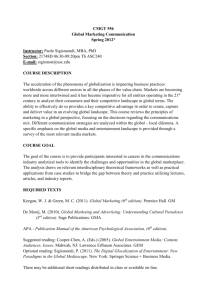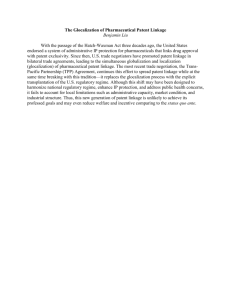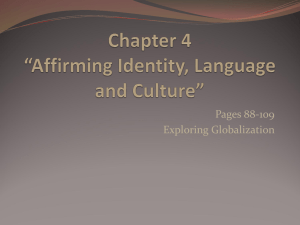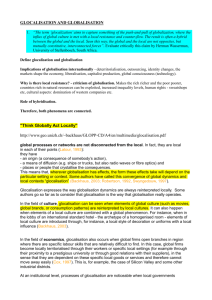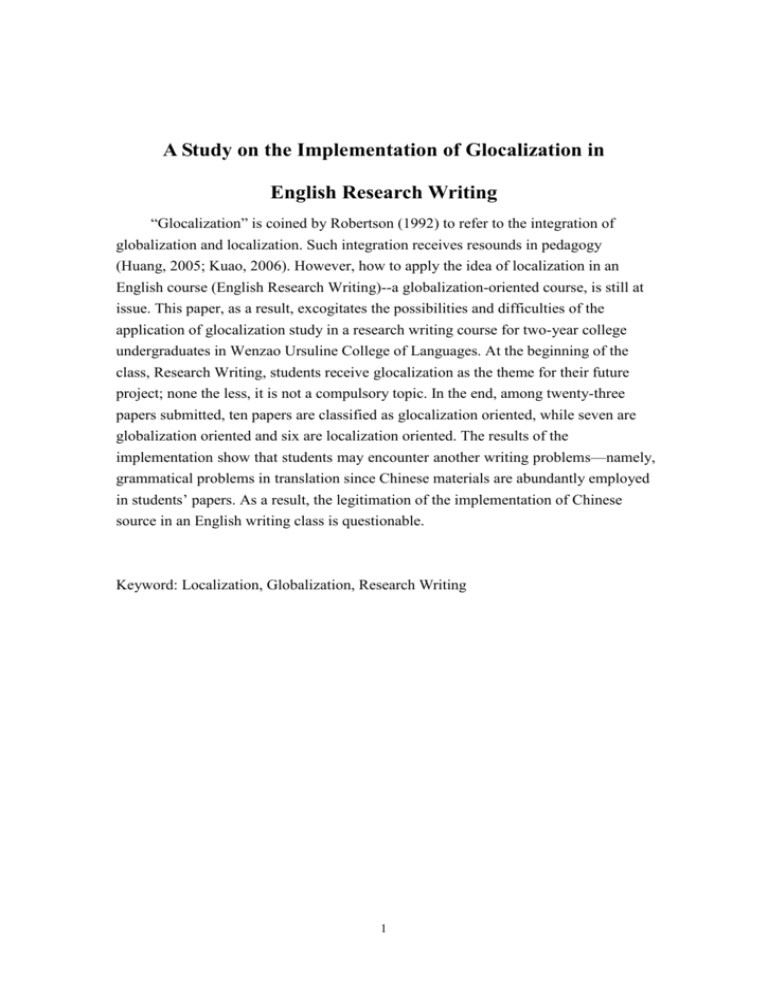
A Study on the Implementation of Glocalization in
English Research Writing
“Glocalization” is coined by Robertson (1992) to refer to the integration of
globalization and localization. Such integration receives resounds in pedagogy
(Huang, 2005; Kuao, 2006). However, how to apply the idea of localization in an
English course (English Research Writing)--a globalization-oriented course, is still at
issue. This paper, as a result, excogitates the possibilities and difficulties of the
application of glocalization study in a research writing course for two-year college
undergraduates in Wenzao Ursuline College of Languages. At the beginning of the
class, Research Writing, students receive glocalization as the theme for their future
project; none the less, it is not a compulsory topic. In the end, among twenty-three
papers submitted, ten papers are classified as glocalization oriented, while seven are
globalization oriented and six are localization oriented. The results of the
implementation show that students may encounter another writing problems—namely,
grammatical problems in translation since Chinese materials are abundantly employed
in students’ papers. As a result, the legitimation of the implementation of Chinese
source in an English writing class is questionable.
Keyword: Localization, Globalization, Research Writing
1
Globalization, Localization and Glocalization
Tomlinson (1991) defined globalization as the “rapidly developing process of
complex interconnections between societies, cultures, institutions and individuals
world-wide” (p. 170). Waters (1995) predicted that postmodernism has been the main
concept of the 1980s’ while globalization, the 1990s. Waters was right except he
failed in foreseeing the side-effect of globalization. Due to the universalism of
globalization, diversity of cultures is eliminated, heterogeneity, degraded, and even,
identity, unified. Held & McGrew (2003) disclosed, “While global markets do not
entail the end of the state as an economic unit, they nevertheless severely erode
national economic sovereignty” (p.299). Barker pointed out, “[w]e do not have an
identity, rather we are a fractured self made up of a multiple weave of attitudes and
beliefs" (p. 169). Hall (1991) indicated that generally, globalization “is centered in the
West and it always speaks English” (p. 179). As a result, localization is added with
globalization to “[synthesize] the relationship between cultural homogenization and
heterogenization, convergence and divergence, and universalism and particularism”
(Maynard & Tian, 2004, p.288). Robertson, consequently, dubs the new combination
of globalization and localization as glocalization.
Robertson (1990) in “Glocalization: Time-space and homogeneityheterogeneity” explains how he uncovers the term,
According to the Oxford Dictionary of New Words (1991:134) the term
“glocal”and the process noun “glocalization”are “formed by telescoping
global and local to make a blend”. Also according to the Dictionary that
idea has been modeled on Japanese dochakuka (deriving from dochaku
“living on one’s own land”)…. More specifically, the terms “glocal” and
“glocalization” became aspects of business jargon during the 1980s,… By
now it has become, again in the worlds … “one of the main marketing
buzzwords of the beginning of the nineties”. (p.28)
Glocalization was originated from the farming culture in Japan where residents
employed the term to promote their farming results beyond their own locus. And then,
such a strategy was accepted by local companies in Japan and furthermore worldwide.
Economically, glocalization is “the process whereby global corporations tailor
products and marketing to particular local circumstances to meet variations in
consumer demand” (Maynard, 2003, p. 6). Robertson affirmed that he raised the term,
glocalization, is due to the weakness of globalization (p.40) and emphasis on space,
on locality (p.26).
The synthesized-glocalized trend also poses impact in Taiwan pedagogy.
Cultivation of local and international consciousness (鄉土與國際意識) has been listed
as the basic principle/guideline in the Nine-Year Integrated Curriculum Outline
2
released in 1998 by the Ministry of Education (MOE). In the course objective, cultural
learning and global understanding (文化學習與國際瞭解) is classified as one of the ten
basic competence (十項基本能力). And then, English is taught in the elementary school
instead of junior high school since 2004. Taiwan is on the way to both globalization and
localization (Chuan, 2003; Chen & Hsueh, 2001). In the English Department where
courses are supposed to be closely associated with English the language, and English the
culture, yet, Wenzao opens a course titled as Overview of Local Cultures in Taiwan (本土
文化外語導覽)1 to ignite the possibility of the integration of English teaching and
locally cultural learning. Being inspired by such a marvelous blending in Overview of
Local Cultures in Taiwan, the instructor/researcher, taking advantage of another course,
Research Writing, intends to excogitate how such a combination is workable and/or even
suitable in an academic writing; therefore, in September, 2009, in Research Writing, the
researcher announced glocalization as the theme and started the experimental try.
In such a writing class, the researcher intends to discover,
In such a writing class, the researcher intends to discover,
1. the feasibility of glocalization in a writing class;
2. the advantages and disadvantages of such application.
3. the possible identity-awareness in terms of writing
Glocalization in Class
Despite that glocalization has been promoted for years by scholars (Bauman 1998;
Kraidy, 2002;Robertson, 1995; Roudometof, 2005; Svensson, 2001; Wellman, 2002),
specified details on the strategies and contents in pedagogy are still unsure. Huang
(2005) interpreted Robertson’s glocalization and classified six different cadres “global
field”, “a sense of particularistic locality”, “wilful nostalgia” “universalismparticularization” and “searching for fundamentalism” as the key spirit. Lee (2009)
re-organized four perspectives of glocalization as
1. multiculturalism
2. interpretation from locus with the emphasis on locality and creativity
3. interpretation of local identity and global value in line with willful nostalgia
1
In the course description of Overview of Local Cultures in Taiwan, it depicts that
Using the English language, this course introduces major cities and tourist attractions in Taiwan
with an extension to related themes concerning local cultures and customs, history and heritage
as well as ecological and geographical features. Parts of the content focus on practical English
use for job specific situations in cultural and tourism industries. Topics to be covered are
Chinese Lunar New Year, Dragon Boat Festival, Ali Mountain, Sun Moon Lake, Taipei,
Kaohsiung, Tainan, and Lukang. Class activities include vocabulary acquisition, speaking and
listening practice, reading and guided writing exercises, group project presentations, and test
preparations for the tour guide/manager license.
Units in this textbook manifest local cultures as the focality.
In fact, the text book for this course, Spotlights on Taiwan, is edited and composed by Wenzoarian
teachers, Yolanda Chi, Isabel Chuo, Andy Hu, and Susu Hung in 2009.
3
and fundamentalism2
4. comprehension of and respect on diversities with paricularism and
universalism
Based on these perspectives, a glocalized course is supposed to provide with
global issues with local history/culture and/or culture or vice versa. Global issues
have been classified by a multitude of critics and scholars. Alger & Harf (1986) raised
issues on pollution, refugee, population, food, energy and safety as global issues.
Muller (1989) proffered five major items as the location of the earth, human family,
human groupings, time location of the earth and individual life. Tsai (2000) deemed
global issues include global problems, systems, culture and value and history and
geography. As to locality-oriented issues, any contents highlighting a distinct local
culture are locally oriented. As a result, local rituals, foods, art and so on are all topics
available.
Generally, in this class, Research Writing, verification of glocalization,
globalization and localization will depend firstly upon whether the issue disused is
local culture exclusively. For example, xia is definitely a term originated from
Chinese culture and should be classified in the study of localization. A study on
MacDonald is global-oriented but a paper on MacDonald in Taiwan is a successful
integration of globalization and localization. A paper on Tizzy Bac, a band known in
Taiwan only is a local study but an employment of a postmodern concept, pastiche
into the study of the band shows another integration of glocalization.
Research Design and Method
Integration of glocalization and localization in Research Writing is voiced out to
twenty-three students in the first week of the fall semester. However, students were not
forced to put glocalization in their research topics.
1. Subjects of the Study
As the aforesaid, subjects in this paper are twenty-three Wenzaorians who are
seniors in the two-year school taking Research Writing (a required class) in 2009.
Research Writing is a yearly course. As a result, students are supposed to
determine their researching topics, finding materials, and submitting pages with an
introduction and literature review in the fall semester. In the spring semester,
students will finish at least a twelve-paged full paper (abstract, main body, and
works cited or reference) before their graduation.
Glocalization as the major theme of this class was announced at the beginning of
the fall semester; however, students were allowed to change their topics if
“Willful nostalgia” by Robertson is the new searching and desire for “being at home” (1992:157).
Such a drive according to Robertson is a strategy of cultural politics and is supposed to promote
national identity (155). Fundamentalism to Roberston is an expectation toward local identity under
globalized shock (175).
2
4
necessary. Students as Shining, Lily, Leanne changed their topics in the spring
semester. Further discussion will be put in the analysis part of this paper.
2. Data Collection
At the beginning of spring semester, students submitted their first draft of the full
paper (ten pages at least). After the modification and suggestions, they submit their
second draft and final draft on April 30 and May 30.
Up to now (March 13), the twenty – three papers (see Table 1) received would be
classified into papers associated with (1) glocalization (10 papers), (2) globalization (7
papers), and (3) localization (6 papers) based on the previous section and definition of
glocalization in class.
G
l
o
c
a
l
i
z
a
t
i
o
n
Table 1. The twenty-three papers and further classification
NO Author
Title
global issues local history/
/ theory
culture
1
Vivian
An interpretation of the
V (global
V (Chinese
Chinese Chivalric Spirit in
movie)
spirit)
Kung Fu Panda
2
Dina
Analysis of the Marketing
V (female
V (Taiwan)
Strategies of Female
underwear)
Underwear-A Case Study on
Audrey
3
JennyH Glocalization of International
V (fast-food
V (Taiwan)
Brand—A Case Study on
store)
McDonald
4
Nita
A Study of Placement
V (placement
V (Taiwan)
Marketing in Love Spreading
marketing)
Over the World
5
Angel
An Analysis on Foreign
V (Foreign
V
Students in Taiwan with the
students)
(Wenzaorians)
Focus on Wenzoarian Foreign
Students
6
Shining Love and Social Value of
V (Sex and V (My Queen)
Queepin in Sex and the City
the City)
and My Queen
7
Ashley
The Postmodern Bricolage in
V
V ( a band in
Tizzy Bac
(Postmodern)
Taiwan)
8
Lucy
A Study of the Sport Marketing
V (Sport
V
of the World Games Kaohisung
Marketing)
(Kaohsiung)
9
Leanne The Chivalry of the Sir Arthur
V (Sherlock
V (Chinese
Conan Doyle’s Sherlock
Holmes)
spirit)
Holmes
10 Annie
A Study on the Japanese and
V (theory
V (Taiwan)
Korean Meteor Garden in
and dramas
Taiwan
from Japan
5
and Korea)
G
l
o
b
a
l
i
z
a
t
i
o
n
L
o
c
a
l
i
z
a
t
i
o
n
11
Lily
12
SandyP
13
Sabrina
14
VickyC
15
JennyW
16
SandyL
17
Mandy
18
Julie
19
Anser
20
VickyK
21
Tina
22
Lesley
Sun Cake in Taiching—A Study
on Yuan Ming Shang Dian
A Study on Mazu Worship in
Changhua City: Nanyao
Temple
A Different World by DSLR:
the Inspirations Come from the
Daily Life
Interrelationship between
Advertisements and Sexual
Information: the Case of Online
Game Advertisements
A Case Study of the
16-Year-Old Ceremony in
Tainan
The Spirit of Wu-Xia in Gin
Yun’s novels
The Characteristic of
Posthuman: A Case Study of
Lady Gaga
Changes of Post- Japan: A
Study on GeGeGe no Kitaro
A Study on Brand
Extension-the Case of
Starbucks.
The Changes of the Witches in
Modern Fantasy Films
Humanism in
Humanoid-Robots: A Case
Study in I, Robots and A.I
(Artificial Intelligence)
Witches in Hollywoodian
Movies: the New Types of
Witches
X
V (Taichung)
X
V (Changhua)
X
V
(Kaohsiung)
X
V (Taiwan)
X
V (Tainan)
X
V (Chinese
culture)
X
V
(posthuman
and Lady
Gaga)
V (Japan)
X
V
(Starbucks)
X
V (witches
and Modern
films)
V (robots)
X
X
V (witches
X
and
Hollywood
movies)
23 Anita
A Study on Absolut Vodka’s
V (Absolut
X
Print Ads.
Vodka)
In addition to the paper collection, a question paper is also sent to ask for students’
feedback. Questions in this paper include,
1. The topic of my paper is
2. Categorize your paper in the following three selections: globalization,
6
localization, and globalization
3. What is/are the problem(s) you encountered in writing your paper?
4. What have you learned in the whole procedure of your writing?
5. Do you recommend the class, Research Writing, to the followers? Why or why
not?
The course, Research Writing, is undergone a modification; hence, albeit
irrelevant, Question 5 is added up to ask students’ opinion. The result of the other four
questions will be excogitated in the next section of this paper.
Analysis
From September 2009 to date (March 2010), it has been more than a half year.
In the very beginning, when glocalization was mentioned in class, students’ were
confused because never had they heard of the term. However, the idea did interest
them and therefore, ten of them tried to make the topic, glocalization, feasible in
working on their papers. However, problems are received during their composition.
1. Problems in Topic Selections
The idea of glocalization is fresh and new and many learners in this class had
showed interest. However, it happened that students are indeed familiar with their
home, the locus, when it comes to global issues, they were confounded. As a result,
six papers narrow down the scope into local culture while seven papers take only
globalization as their major agenda.
Among them, Mandy changed her interest on Sunny Huang (a singer with a
priest as her husband) to Lady Gaga to show her more worldwide scope. Nita began
her paper with insurance as her topic; however, she was advised by the instructor to
find something she was interested in and she turned her topic into the study of a
longevity drama, Love Spreading Over the World (真情滿天下), in terms of a
globally promotion strategy—placement marketing. Shining had intended to find
foreign foods in Kaohisiung and quit because of the little feasibility. She turned to the
study of May Day, a famous local band, and quit again since she was not inspired of a
good study topic. Ultimately, her paper started a comparison between two famous
drama worldwide and locally, Sex and the City and The Queenpin (敗犬女王) and
successfully integrated glocalization into her paper.
Leanne started her paper on the influence of European Union on the tourism in
France. She quit because of low score by the instructor3 and her new topic was the
study of chivalric spirit in Shylock Holmes.
Vivian is always fond of Disney’s animation. She attempted to write something
about that. Due to chivalric spirit was frequently mentioned in class, she decided to
3
She failed to get a good grade because she did not show herself capable of handling the topic with
France and European Union included and yet she has never been to France and she is not very much
fond of politics.
7
disclose the chivalric spirit in a Chinese-like but Disney-made film, Kung Fu Panda.
In addition to the selection, two students failed to classify their papers. By
chance, both of them present glocal papers but they just could not put their papers in
the category.
2. Problems in References/Works Cited
Since MLA writing style was taught in the fall semester, all students followed
MLA writing style in submitting their papers. However, the dilemma went to the
instructor/researcher. Since glocalization was announced as the topic, it was in
avoidable that Chinese references would be applied frequently. It turned out a big
problem. For students whose papers are glocalized or localized oriented, they used
plenty of Chinese references. In Vivian’s paper, among the 24 entries, only four of
them are English ones. In SandyP’s paper on Mazu, there is no English entry at all.
Research Writing is opened to train learners’ English writing and reading
abilities. In this way, apparently, too many Chinese entries mean a failure of English
reading training for this course.
3. Problems in writing
This is a follow-up problem of Problem 2. Due to the Chinese source, students
spent time translating the Chinese quotes. It also turned out that they had great trouble
in translation be it in grammar or in expression.
In SandyP’s paper, she translated a quote as
Many people think that Hakkaese(客家人) always worship in San Shan
Guo Wang(三山國王) but it is not true. After many migrations, they faced
to the new environment and crisis. In order to existence, they had to use
the main culture of Central Plains(中原文化) or absorbed the other
culture . Because of these reasons that Hakkaese can existence in this
competition. (1)
Likewise, Nita demonstrates how severely she is influenced in the Chinese quote,
“Yi-Lung, Chou (周亦龍) states that Nowadays, the community is cable television’s
generation; it is not only payment, but also is compelled to accept the policy’s
propagations through placement marketing”. Some students demonstrate their
mastering in the translation. Yet, the two example above illustrate pidgin wriitng
produced by a Chinese reading.
Ten of the paper-authors (not limited in glocalization as the topic) mentioned
about the difficulties in translation, five of them specify,
Question: What is/are the problem(s) you encountered in writing your
paper?
Anser: “Sometimes, I have to translate Chinese books into English.
SandyL: The topic is relative to Chinese culture, so it is hard to find more
8
English information or paper
Shining: Translating the conversation of series of Queenpin
VickyC: it’s a little difficult to translate Chinese to English
SandyP: It’s hard to translate some Chinese to English
On the other hand, those who took globalization as their major themes or insist
on using English materials seldom had the translation problems except two of them
were caught plagiarism. And they failed in the first draft.
The researcher had offered the same course in 2008; however, at that time,
Chinese references were not allowed at all. It happened that five of them got caught
plagiarism. In utilizing Chinese source, students are frustrated in the translation.
When English source is applied, students, however, may get caught for plagiarism.
4. Satisfaction?
Despite of the language problems, students who had local culture as their topics
felt it much more interesting. Survey was not conducted, however, on their
satisfaction because of the frustration of paper writing to most students regardless of
the topics they select.
It is nevertheless detectable in terms of the page number. Among the
twenty-three papers, Vivian’s, JennyH, Nita’s, Shining’s, Lucy’s, SandyL, Lesley’s
and Anwer’s were over twenty pages. The last three papers are not
glocalization-oriented. Namely, 21% (five among the twenty-three papers) of them
take glocalization as the topics and successfully uncover sufficient information and
materials.
Conclusion and Suggestion
All in all, the first thing troubles the researcher/instructor is the legitimacy in an
English class. Due to too many Chinese entries and information, few students achieve
one of the objectives of the class--abundant reading. However, their writing is greatly
improved thanks to Chinese-English translation. Nita told me she asked for a help
from a friend who spent a Saturday teaching her grammar and improving her paper
writing skill.
Secondly, Robertson unveiled, “to the question of diversity at the local
level. …we should consider the local as a ‘micro’ manifestation of the global.. to the
implication that the local indicates enclaves of cultural, ethnic, or racial homogeneity”
(39). Roberson had also revealed that” the contemporary assertion of ethnicity and/or
nationality is made within the global terms of identity and with overrides local
particularity” (26). Namely, identity and locality are closely interwoven in a glocal
issue. Unfortunately, from students’ reaction on “What have you learned in the whole
procedure of your writing”, most students just take this course an academic writing.
They reply that they have learned a lot about researching writing as MLA writing
9
style, requirements for a paper, information collection, and more vocabulary
acquisition. Except the aforesaid, only few react with a cultural reflection:
Shining: Know the value of women. (But she failed to specify)
Annie: I learn how TV in Taiwan is in need of a new image to attract
viewers domestically and internationally.
SandyL: Wu-xia is not the old fashion anymore because it changes now.
among the fourteen papers the researcher read,
JennyW: I have learned deeper about the process, complete meanings, the
influency of the ceremony. (Again, she failed to specify as well)
SandyP: (1) The building and history; (2) Mazu culture
Among five of the responders, Shining and Annie did a research on glocalization;
SandyL, JennyW and SandyP, on localization. That is, a glocalized research did not
lead to a further identity-quest as it did in a localized research. In fact, to totalize the
rate, 79% of the English learners care nothing about culture nor do they care about
identification but take Research Writing a general language learning course on
writing.
A further comparison with the papers only frustrates researcher more. Most of
the papers merely tell how these students can be good information collectors good at
information gathering but not qualified researchers that can interpret and even
proceed self-awareness during writing. In Nita’s work, advertisements with placement
marking implication are mechanically classified based on the visual and auditory
strategies. No further analysis either on the TV culture or visual/auditory images is
proffered. The same thing happened in Ashley’s observation of a local band, Tizzy
Bac, and its association with postmodern pastiche. Despite SandyP took a visit to the
temple depicted in her paper, she just illustrated the appearance, the activities of the
temple item by item without further delving of the symbols and/or possible cultural
implication. Application of what they have learned is still a tough task for these young
writers.
With so many problems and frustration, the research still enjoys herself in this
course by which both the researcher and students learn about different cultures which
are rarely brought out in other classes. For example, Annie revealed jobs in different
versions of Meteor Garden of different countries can be varied due to local cultures.4
Ashley indeed brought out several good ideas on the comparison between Tizzy Bac
and some postmodern nostalgic images illustrated by Frederic Jameson.5
Annie illustrates, “in Taiwanese version [of Meteor Garde], the setting of the store is a bakery… In
Japanese version, the setting of the store was Wagashi (和菓子) store. And in Korean version, the
backdrop was a store which merchandised Korean porridge”. In terms of the findings, the study indeed
reveals cultural diversities.
5
Despite Ashley claimed to have suffered a lot in this class, she eventually submits a paper with
interesting points by disclosing the pastiche of Tizzy Bac though it is a pity that she fails in specifying
4
10
Research Writing, after all, is just a two-semester course. The
instructor/researcher asked students to submit papers on the first week of the second
semester. This shortens the preparation time within six months. Therefore, the above
disappointments may be resulted from the time problems. In this extent, if more time
is given, these paper writers may demonstrate different results.
References
Alger, C. F. & Harf, J. E. (1986). Global education: Why? for whom? about what?, In
R. E.Freeman(ed.), Promising practices in global education: A handbook of
case studies (p.1-13). New York: National Council on Foreign Language &
International Studies in collaboration with Global Perspectives in Education.
Bauman, Z. (1998) On Glocalization: or Globalization for some, localization for some
others. Thesis Eleven, 54, 37-49.
Bucker, C. (1999). Television, Globalization and Cultural Identities Chris. Open
University Press: Buckingham
Chen, B. Z. & Xue, X. H. (2001). A trend analysis of the concept and pedagogical
development of glocalization. Theory and Policy, 15(4), 49-70.
Chuan, M. J. (2003). The possibility of the curriculum reform in Taiwan. In Chuan,
M.J. (ed), Curriculum reform: Reflection and prospect (pp.175-197). Taipei:
Higher Education.
Chi, Y., et al. (2009). Spotlights on Taiwan. Taipei: Pearson Longman.
Hall, S. (1997). The local and the global: Globalization and ethnicity. In Anne
McClintock, Amir Mufti, Ella Shohat (eds), Dangerous liaison: Gender, nation
and postcolonial perspectives (pp.173-187). Minneapolis, MN: University of
Minnesota Press.
Held, D. & McGrew, A. (eds), (2000). The global transformations reader: An
introduction to globalization debate. Cambridge: Polity Press.
Huang, J. J. (2006). Indigenous curriculum research on the Implication of Roland
Robertson's “glocalization”. Unpublished master thesis. National Taipei
University of Education, Taipei.
Li, S. M. (2009). An action research approach study on the curriculum design with the
concepts of glocalization in primary art and humanity-- With the development in
Chiautou Primary School in Kaohsiung County of the Paper Shadow Puppet
drama as an example. Unpublished master thesis. National Ping Tung University
of Education, Pintung, Taiwan.
Maynard, M. & Tian, Y (2004). Between global and glocal: content analysis of the
Chinese Web Sites of the 100 top global brands. Public Relations Review 30,
the further meanings.
11
285–291.
Maynard, M. (2003). From global to glocal: How Gillette's SensorExcel
accommodates to Japan. Keio Communication Review 25, 57–75.
Ministry of Education, Taiwan (1998). Step onto the learning of social white paper.
Taipei: Ministry of Education.
Muller , R.(1989).A world core curriculum. Social Education, 53(5), 284-286.
Robertson, R. (1995). Glocalization: Time-Space and Homogeneity-Heterogeneity. In
Mike Featherstone, Scott Lash and Roland Robertson (eds), Global Modernities
(pp.25-44). London, Thousand Oaks and New Delhi: Sage Publications.
Roudometof, V (2005). Transnationalism, cosmopolitanism and glocalization. Current
Sociology 53(1), 113-135.
Svensson G.. (2001). "Glocalization" of business activities: a "glocal strategy"
approach. Management Decision, 39(1), pp. 6-18.
Tomlinson, J. (1997). Cultural Globalization and cultural imperialism. In Eli
Homammadi, (ed), International Communication and Globalization (pp.
170-191). CA: SAGE.
Tsai, P. F. (1999). An action study of the infusing global perspectives into the social
science teaching at the elementary school students, grade fourth. Unpublished
master thesis. National Chiayi University, Chiayi.Kraidy, M. (1999). The global,
the local and the hybrid: a native ethnography of glocalization. London: Sage.
Water, M. (1995). The new world chaos: cultural globalization. London: Routledge.
Wellman, B. (2002). Little boxes, glocalization, and networked individualism. In M.
Tanabe, P. Besselaar and T. Ishida (Eds.), Digital cities II: Computational and
sociological approaches (pp.10-25). Berlin: Springe.
12


